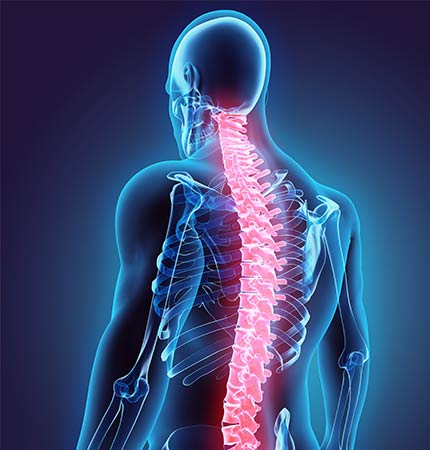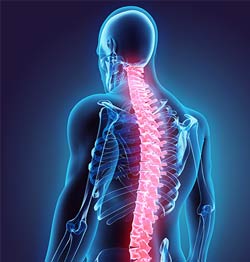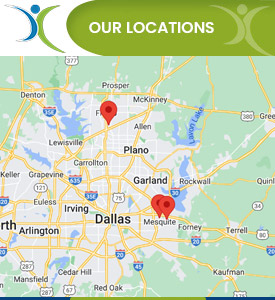Ankylosing Spondylitis Pain Specialist Serving DFW, Frisco, Sunnyvale, and Mesquite, TX
Are you suffering from stiffness, lower back pain, or neck pain? Joint pain, neck pain, or hip pain may occur sometimes, but recurring symptoms may indicate a painful condition called Ankylosing spondylitis. Ankylosing spondylitis is one of the many back conditions treated by our specialists at OmniSpine Pain Management Clinic. Contact us or book an appointment for your ankylosing spondylitis condition. Our clinics are located in Frisco, TX, Sunnyvale, TX, and Mesquite, TX.


Table of Contents:
What is ankylosing spondylitis (AS)?
What causes ankylosing spondylitis (AS)?
What are the symptoms of ankylosing spondylitis (AS)?
How is ankylosing spondylitis (AS) managed or treated?
Ankylosing Spondylitis is a type of inflammatory disease that can cause vertebrae in the spine to fuse. The fusing of the vertebrae makes the spine less flexible. This can create a hunched-over posture. This posture can then make it difficult to move or even breathe deeply.
Ankylosing Spondylitis (AS) happens more frequently in men than it does in women. Signs of this can start to be seen in early adulthood. Inflammation from AS can also happen in other areas of the body, like the eyes. There is no cure for AS and treatments for it are directed toward lessening the symptoms and slowing the progression of the disease.
Ankylosing spondylitis typically affects men and can eventually leave a person with a hushed posture. If it is treated early, many of the complications from this disease can be prevented or at least slowed, to maintain a better quality of life.
Ankylosing Spondylitis (AS) has no apparent cause, however, genetic factors seem to be a part of this condition. There appears to be a genetic component related to a gene called HLA-B27. People who have his gene are at a greater risk of developing AS, but this does not happen to everyone who has the gene. There are risk factors involved in the development of AS. Men are more likely to develop AS than women. It generally begins in late adolescence or early adulthood.
In severe cases of AS, new bone is formed as the body attempts to heal. The new bone will gradually grow and bridge the gap between vertebrae which fuses sections of the spine. Those areas of the spine will become stiff, preventing fluid motion in the spine. This disease can also stiffen the rib cage, which in turn limits lung capacity.
AS can impact other areas of the body. One of the most common complications is eye inflammation or uveitis. This can cause sudden eye pain, blurred vision, and sensitivity to light. It is recommended that you see your doctor if you experience any of these symptoms.
Ankylosing Spondylitis (AS) can cause compression fractures as it can weaken the bones. Weakened vertebrae can crack or break which increases the severity of the hunched posture. Compression fractures can also put pressure on the spinal column, causing damage to the spinal cord and the nerves that come through the spine.
AS can cause heart problems, in particular with the aorta. An inflamed aorta can reduce the function and shape of the aortic valve and can increase the risk of heart disease.
Early signs and symptoms of AS can include pain and stiffness in the hips and lower back. These will most likely be felt in the morning or after periods of inactivity. Neck pain can be associated with AS, as well as fatigue. Symptoms can get worse over time. They can also stop or lessen at irregular intervals.
There are areas of the body that are most commonly impacted by AS. These areas are the joint between the pelvis and the spine where the vertebrae in the lower back can be impacted. Other regions include the places where ligaments and tendons attach to bones in the spine, or sometimes in the back of the heel. Moreover, this also includes the cartilage located between the ribs and breastbone, and of course, the shoulder and hip joints can also be impacted.
The primary goals for treatment of AS are to relieve pain, limit stiffness, and delay the onset of spinal deformity or other complications. An early diagnosis of AS makes treatment more successful and can help prevent irreversible damage.
So, what does a pain management doctor do? Medications can be a good choice in treating AS. Medication management and anti-inflammatory medications like naproxen and ibuprofen are commonly used. They relieve pain, stiffness, and inflammation. If those are not helpful, your doctor may prescribe something to block the pain.
On the other hand, therapies can help manage the complications of AS. It can help provide pain relief due to improved strength and flexibility. Physical therapy can give you better posture, range of motion, strength of the back and abdominal muscles, and work with proper sleeping and walking positions. In more severe cases, surgery may be required to reduce more severe pain or if your hip has become damaged and needs to be replaced.
OmniSpine Pain Management specializes in assisting you with your ankylosing spondylitis pain. Call us or book an appointment for your ankylosing spondylitis condition. We serve clients from Dallas TX, Frisco TX, Mesquite TX, Sunnyvale, TX, Plano TX, Garland TX, Forney TX, Cedar Hill TX, Denton TX, Balch Springs TX, and surrounding areas.





